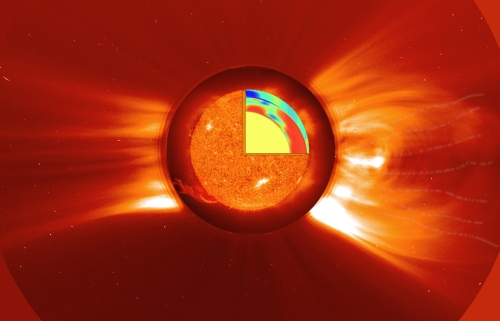Sun & Solar System

A composite image of the Sun that depicts the range of scientific research -- The interior image from MDI/SoHO illustrates the rivers of plasma discovered flowing under the Sun’s surface. The surface image was taken with the Extreme ultraviolet Imaging Telescope (EIT) at 304Å. Both were superimposed on a Large Angle Spectroscopic Coronograph (LASCO) C2 image, which blocks the Sun so that it can view the corona in visible. The image suggests the range of our research, from the solar interior, to the surface and corona, and out to the solar wind.
Solar Physics Discussion Meetings
Solar MHD
Magnetic fields are present almost everywhere on the Sun. Without these fields the Sun would have been a rather dull object. One of the major challenges of solar physics is to understand the role of magnetic fields. Magnetohydrodynamics (MHD) describes the behaviour of plasma in the presence of magnetic field. Solar MHD attempts to explain the magnetic Sun.
IIA scientists are involved in studying the structure and dynamics of the magnetized solar chromosphere, wave propagation in magnetic network, mode coupling and conversion in magnetic flux tubes and energy transport mechanisms in the solar atmosphere.
Recent Highlights:
- Magnetostatic structures in the partially ionized solar atmosphere (V. Krishnan)
- Dynamics of magnetic network usig two dimensional MHD simulations (S. S. Hasan)
- Wave propagation and energy transport in the magnetic network of the Sun (G. Vigeesh)
Waves and Oscillations
Waves permeate the entire Sun. Studying these waves give us a clue about different properties of the solar atmosphere. Using various ground based and space based telescopes to observe the Sun in different wavelengths, IIA scientists try to identify and study various wave modes that are present on the solar atmosphere.
Helioseismology is the study of wave oscillations in the Sun. We use the techniques of local helioseismology to understand the interior of the Sun, especially the sub-surface structure of sunspots.
Recent Highlights:
- Alfven waves and magnetoacoustic slow waves in the polar coronal holes (D. Banerjee)
- Study of solar interior through gravity modes (S. Mathur)
- Sunspot seismology: Control experiments on surface magnetic effects (S. P. Rajaguru)
Solar Coronal Studies
Recent Highlights:
- Coronal helicity in emerging active region (B. Ravindra)
- Variability of coronal background X-ray emission (K. B. Ramesh)
- Kinematics of metric type II radio bursts, and Coronal Mass ejections (K. R. Subramanian)
- Low frequency radio observations of coronal magentic fields (R. Ramesh)

